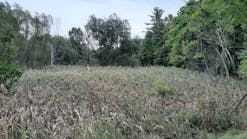By David Gray, Robert Grese, and Tammy Orlow
School Girl’s Glen is a steep ravine in Nichols Arboretum in Ann Arbor, MI. The arboretum, which adjoins the University of Michigan to the east, is located on the flank of a glacial moraine that overlooks the Huron River valley. The glen is part of the Huron River drainage that flows into Lake Erie. The stream that flows out of the glen is intermittent and drains a watershed of approximately 33 ac. The stream is fed entirely by stormwater runoff, so it fluctuates between being nearly dry and discharging large amounts of water. Much of the glen’s watershed is impervious (University of Michigan roads, buildings, parking lots, and so on) or nearly impervious (Forest Hills Cemetery, arboretum roads and paths, and steep slopes). This causes high amounts of runoff to enter the glen after storm events. Prior to watershed restoration work, there were no stormwater detention facilities or erosion control measures in the watershed. This article describes a number of innovative techniques implemented over a two-year period to handle this runoff and stop further erosion in the glen. The project serves as a highly visible erosion control demonstration project that has provided innumerable hands-on opportunities for volunteer participation. Visitors to the arboretum now can follow a self-guided tour, called the Clean Water Trail, that showcases the various erosion control measures and techniques.
History
Nichols Arboretum is a magnificent 123-ac. property that was donated to the University of Michigan in 1906. School Girl’s Glen is located in the northwest corner of the arboretum near the border the arboretum shares with the University of Michigan Medical Center. The arboretum’s proximity to the university and its beautiful landscape attract many visitors during the year. At one time, School Girl’s Glen was admired as a peaceful forested glade and stream that descended from the arboretum’s west entrance down to the Huron River. Over time, neglect combined with increasing and unregulated runoff into the glen from the surrounding area initiated severe erosion and massive discharges of sediment into the Huron River. The once-beautiful glen slowly was converted into an incised ravine and a degraded drainageway. The road running alongside the glen at one time offered dramatic views into the glen itself and across the entire Huron River valley. Eventually the views across the landscape became partially obscured by tall trees-but more importantly by a dense understory of invasive vegetation, such as common buckthorn, honeysuckle, and privet.
Erosion Problems
The problems facing School Girl’s Glen are multifaceted. High runoff from impervious surfaces in the watershed combined with direct discharges from street drains have resulted in large storm flows and serious erosion problems. Concentrated runoff from roads in Forest Hills Cemetery above the glen flowed unchecked past the arboretum’s environmental interpretive center that made access to the building difficult during storms and completely disrupted plans to construct a “gateway” garden at the west entrance to the arboretum.
Uncontrolled storm flows have caused both channel head-cutting and down-cutting in the glen itself. This in turn has undermined adjacent streambanks and sideslopes, which has resulted in serious slope failures. The combination of surficial erosion, channel scour, and slope failures has produced massive losses of soil. At low water, a large sediment delta is clearly visible at the confluence of the glen’s ravine with the Huron River.
A cavity analysis using topographic maps from 1965 and 1993 estimated that 13,500 yd.3 of soil washed out of School Girl’s Glen and into the Huron River during this time period. This estimate works out to an average of about 480 yd.3/yr., or an average of about 1.3 yd.3 of soil washed out of the glen per day. Given the fact that the glen has been handling an ever-increasing amount of water, this soil loss probably has accelerated during the last decade prior to repair and restoration work.
The soils in the glen are well drained to moderately well drained and sandy loam to clay loam over a hard till, which is exposed at the bottom of the ravine. Soils exposed in the sideslope failures are variable, with boulders often embedded in the matrix. The areas with sandy to loamy soils are highly erodible when the vegetation is removed. The hard-packed clay till, which lines parts of the ravine, is less erodible but still vulnerable to down-cutting during storm flows.
One of the factors contributing to erosion of the steep slopes in School Girl’s Glen is the prevalence of non-native invasive species. In an area historically dominated by oak-hickory forest with its open canopy and richly developed layers of vegetation, invasive shrub and tree species, such as common buckthorn (Rhamnus cathartica), Mack’s honeysuckle (Lonicera maackii), Tartarian honeysuckle (Lonicera tatarica), common privet (Ligustrum vulgare), and Norway maple (Acer platanoides), greatly have shaded out the native understory vegetation and prevented regeneration of the native oak and hickory species. The lack of a healthy, understory vegetative layer greatly increased the site’s vulnerability to erosion.
Repair and Restoration Goals
Nichols Arboretum received a $25,000 grant in 2001 from the Great Lakes Basin Commission to work toward solving the erosion problem in School Girl’s Glen. The main goal of the School Girl’s Glen project, as described in the grant proposal, was “to arrest the erosion and slope failures that are occurring in School Girl’s Glen and to eliminate sediment discharges to the Huron River.” A related goal was “to carry out this remedial work as a demonstration project using environmentally sensitive stream bank protection and erosion control methods.” A highly desirable concomitant goal, of course, would be to work on source reduction-that is, to reduce or divert the amount of runoff entering the glen. For a variety of reasons, this was not an option available to the project.
Work began in School Girl’s Glen in July 2001 and continued through August 2003. The physical work needed to construct and implement most of the erosion control measures was accomplished largely by volunteers and Nichols Arboretum staff. The services of a professional engineering firm and earthwork contractor were engaged to design and construct a series of stepped pools or low-head drop structures at the head of the glen.
Repair and Restoration Methods
A variety of different techniques were implemented in School Girl’s Glen to correct and mitigate existing problems. Although source reduction was not a project option, some effort was directed at detaining and controlling runoff entering the head of the glen. This was accomplished mainly by constructing a series of landscaped stepped pools. Other measures were implemented to better handle street-drain discharges that had initiated tributary gullies on the sideslopes of the glen.
The techniques selected were relatively low-cost, environmentally sensitive measures that could be implemented using volunteer or arboretum staff labor. The range of techniques selected included the following:
- Stone weirs
- Silt fencing
- Live staking and native planting
- Gabion check dam and root-wad revetment
- Invasive plant/tree removal and revegetation
- Channel armoring and realignment
- Reinforced-earth repair fill
- Boulder cascades
- Stepped pools
A brief description of some of these techniques employed in the glen follows.
Stepped Pools
A series of stepped pools was constructed at the head of School Girl’s Glen to handle and slow runoff flowing into the head of School Girl’s Glen. The stepped pools were designed by the engineering consulting firm of Ayres, Lewis, Norris, and May. Generally stepped-pool structures occur in natural, steep-gradient perennial streams. The pool system built in the arboretum is perhaps better described as a series of low-height, boulder drop structures connected by a low-gradient channel. These structures lower existing channel velocities and provide a stable channel environment.
A total of six pools or low-height boulder drops were constructed. The top three pools handle runoff from Forest Hills Cemetery that previously had flowed unchecked past the environmental interpretive center building. The runoff flow into these pools originates from a subwatershed with a 17-ac. drainage area consisting mainly of cemetery property, including approximately 6,600 ft. of 11-ft.-wide asphalt and compacted gravel roads. The calculated peak 10- and 100-year recurrence interval flow rates for these pools are 5.0 and 16.5 cfs, respectively. An outlet drain conveys additional storm runoff from the adjacent Washington Heights subwatershed with a drainage area of approximately 1.3 ac. This drainage area includes mostly impervious roadway and roof surface and some surrounding lawn areas. The calculated 10- and 100-year recurrence interval flow rates from the combined flows that must be handled by the lowermost three pools are 7.0 and 19.7 cfs, respectively.
The channel between pools was designed to carry the 100-year peak flow at a nonerosive velocity. A triangular channel at a 1% slope was selected to minimize earthwork and provide a subcritical channel design. Based on Manning’s equation, the maximum velocity in the channel during the 10-year event will be 2.6 ft./sec. The Natural Resource Conservation Service assumed that a minimum of Type-B vegetation would be required to adequately stabilize the proposed channel. Type B includes various native Midwest grasses. A variety of prairie and river’s edge species were planted, such as riverbank sedge (Carex emoryi), prairie cordgrass (Spartina pectinata), Gray’s sedge (Carex grayi), Indian hemp (Apocynum cannabinum), blue flag iris (Iris versicolor), and cup plant (Silphium perfoliatum). Calculations showed that the allowable velocity in a channel with this type of vegetative lining is 6.6 ft./sec. Accordingly a Type-B vegetative cover will provide adequate stabilization in the channel.
Construction of the pools and the connecting channel commenced and was completed in the summer of 2003. A considerable amount of earthwork grading was required to shape the channel and surrounding banks. A geotextile filter fabric was placed behind and beneath the boulders to prevent washing of fines through the rock. Topsoil was added to the regraded surfaces and then covered with a straw-filled erosion control blanket that was securely fastened to the ground. A selected spectrum of grasses, herbaceous vegetation, and shrubs then were transplanted or sprigged through the blanket into the topsoil beneath. The planting design was carried out according to a plan developed by a professional landscape architect.The stepped-pool system has been tested severely by several storm events that occurred shortly after construction and before establishment of vegetation. Nevertheless, the system has performed well and largely as expected. The pools temporarily detain storm runoff and even out the flow of water. Temporary detention in the ponds, which have pervious bottoms and native vegetation, also permits some of the runoff to infiltrate the ground, as opposed to discharging into the head of the glen below. Phreatic vegetation (e.g., sedges, rushes) growing in the pools and connecting channel help clean runoff water as it flows through them via a process of phytoremediation.
Silt Fencing
Prior to construction of the stepped pools, runoff from Forest Hills Cemetery flowed directly down an asphalt driveway and into the head of the glen where it caused significant head-cutting. To solve this problem temporarily, a silt fence was installed at the head of the glen. Silt fences are not normally recommended for intercepting and diverting concentrated flow; however, the fence was designed and constructed to withstand impinging flows and worked satisfactorily until a permanent solution-namely, construction of the stepped pools-was devised.
Gabion Check Dam
A low gabion check was constructed across a critical reach of channel where active down-cutting and incision had destabilized adjacent banks, causing tree topples and slope failures. The trunks and limbs of the toppled trees made matters worse by obstructing and diverting storm flows against already unstable banks. A City of Ann Arbor forestry crew lifted most of the trees out of the glen but left behind the root wad of a large oak and about 4 ft. of the trunk. The root wad remained in the middle of the channel where it continued to divert water toward an unstable bank. Prior to constructing the check dam, the root wad was moved to the side of the channel and positioned with its roots facing upstream to act as a revetment and to help protect the toe of the unstable sideslope.
The wire baskets were filled with 5- to 7-in. stones delivered to the work site from the rim of the ravine by means of a long, 18-in.-diameter flexible polymeric tube. The gabion dam was inset into the channel, and its ends were placed behind hard points to prevent flanking and undermining. The gabion baskets also were placed in an 8-in.-deep trench dug across the channel to prevent washout under the dam. The completed gabion dam is 15 ft. wide, 3 ft. deep, and about 3.25 ft. high, except in the middle where there is a 1-ft.-deep notch.
One week after the gabion check dam was completed, a thunderstorm occurred and generated large flows in the glen. The channel area behind the dam completely filled in with sediment. This did not affect down-cutting protection provided by the dam but did render the dam incapable of trapping anymore sediment. A volunteer group shoveled out the sediment from behind the dam and piled it along the toe of the eroded, failed slope. This served to buttress the toe of the failed slope above and allow additional sediment-trapping capacity in the future. An estimated 30 yd.3 of total sediment has been collected behind the gabion dam and smaller check dams since their construction in 2001.
Channel Modifications: Boulder Cascades and Stone Weirs
A series of channel modifications, consisting mostly of repositioning boulders in the channel, were undertaken to move flow away from unstable areas and to dissipate energy by increasing channel roughness and creating low-head drops. An artificial boulder cascade that mimicked a natural cascade in the glen was constructed immediately downstream of the gabion dam to help dissipate the energy of the water flowing over the dam.
Naturally occurring boulders also were used to construct a series of stone weirs or low-head-drop, grade-stabilization structures at critical locations along the channel. These served to decrease the channel gradient, trap some sediment, and dissipate energy of the flowing water. The stone weirs were constructed about 1-2 ft. high.
Reinforced-Earth Repair Fill
A box elder that toppled into the channel left behind a large cavity in the eastern bank of the glen. Seepage erosion and groundwater piping continued to enlarge the cavity. The cavity was filled and the bank was restored to its original contour by backfilling with layers of sand wrapped (reinforced) with recycled, fiber-backed carpeting. A geotextile fabric normally is used for this purpose; however, one of the ancillary goals of the project was to minimize costs and capitalize on recycling opportunities. Coarse gravel was placed at the bottom and back of the cavity to intercept groundwater seepage. Live stakes were inserted in and around the reinforced repair fill, and the entire area was mulched. The species used for live staking here were red-osier dogwood (Cornus stolonifera), willow (Salix spp.), and prairie rose (Rosa setigera). The fill has held up well since its placement in spring 2001.
Invasive Plant Removal
Invasive species were targeted for removal during the project to promote the establishment of native ground covers and enhance vistas into the glen. The most pervasive plant invaders were common buckthorn (Rhamnus cathartica) and Amur honeysuckle (Lonicera maackii). Other woody species targeted for removal in School Girl’s Glen included Norway maple (Acer platanoides), Tartarian honeysuckle (Lonicera tatarica), common privet (Ligustrum vulgare), and tree-of-heaven (Ailanthus altissima). Most woody species were cut, and the stumps were painted with Roundup herbicide. Norway maples were girdled to avoid resprouting. Herbaceous species were pulled by hand. Removing these invasive species has been a key step in promoting a diversity of protective ground-layer vegetation and encouraging regeneration of native trees and shrubs in the glen.
Live Staking and Native Planting
Live staking was used to reestablish vegetation and help stabilize selected sideslope areas in the ravine. The live stakes, mostly willow, were cut in Nichols Arboretum or nearby natural areas along the Huron River. Live staking was most successful near the head of the glen because it is relatively unshaded and remains wet as a result of seepage and springs in the area. Survival was also satisfactory in a sediment accretion site upstream of the check dam where several revegetative techniques were used. This area and the toe of a previous slope failure were live-staked with ninebark (Physocarpus opulifolius), silky dogwood (Cornus amomum), willow, and prairie rose.
Seedling trees, including oaks (Quercus spp.), redbuds (Cercis canadensis), and sassafras (Sassafras albidum), were planted in 2002 in other areas of the glen to help stabilize slopes and revegetate the area with native trees. Herbaceous species, including false Solomon’s seal (Smilacina racemosa), wild geranium (Geranium maculatum), and lady’s thumb (Polygonum persicaria), were transplanted in June 2002 to eroding slopes from other areas of the arboretum. In summer 2002, plugs of Gray’s sedge were sprigged into the moist lower banks near the head of the glen to prevent further erosion. Most of the sedges have survived; their roots now help hold the soil in place. In late April and early May 2003, plugs of cow parsnip (Heracleum maximum), spikenard (Aralia racemosa), and rough sunflower (Helianthus hirsutus) were planted throughout the lower part of the glen. All these plantings appear to be thriving and providing protective ground cover.






